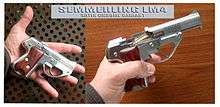Semmerling LM4
| Semmerling LM4 | |
|---|---|
 Semmerling LM4 - Satin Chrome Variant | |
| Type | Compact pistol |
| Place of origin |
|
| Production history | |
| Manufacturer | Semmerling |
| Specifications | |
| Weight | 560.4 g (19.77 oz) fully loaded |
| Length | 93.98 mm (3.7") |
| Width | less than 25.4 mm (1") (21.59 mm (0.85") with "thin kit" |
|
| |
| Cartridge | .45 ACP |
| Action | manual-repeating Double action |
| Feed system | 4+1 round magazine |
| Sights | fixed iron sights |
The Semmerling LM4 is a five-shot, manual repeating double-action pistol designed for backup purposes.
Concept and History
The Semmerling series of pistols included the LM1, LM2, LM3, LM4 and XLM. The only version available to the public was the LM4 which was first designed and manufactured in the U.S.A. in the early 1980s and marketed at a price of US$750. The "LM" in the model numbers stands for "Lichtman Model", after the inventor of the design, Philip R. Lichtman. Lichtman applied for and received at least four United States Patent's related to the design.[1]
The goal of the LM4 was to achieve a combination of the highest practical firepower in as small and light a gun as possible, so as to be easily concealable. This was approached by selecting the service caliber of .45 ACP for its proven stopping power and opting for a manual repeating mechanism to minimize bulk and weight and ensure flawless operation in the most difficult situations. Because of this the LM4 was first offered to the U.S. Army and government agencies.
The Semmerling LM4 is simple, having only 33 parts (including screws). The original design called for every part except for the springs to be made of S-7 tool steel. Every pistol was Magnafluxed (a method of testing ferrous metals for surface and subsurface flaws) twice in their assembly.
Each pistol was essentially handmade to order with production averaging a little over ten pieces a month. Of the LM4 model, only about 600 were ever produced.
Although the Semmerling was intended as a back-up pistol for those most at risk of having their primary weapon taken from them, some adopted the pistol as a "hide-out" weapon. It is capable of a "shot-a-second" firing rate. With the magazine loaded and a round in the chamber, the Semmerling LM4 is capable of carrying five .45 ACP rounds.
During 2005, the largest collections of Semmerlings comprising examples of the LM1, LM2, LM3, LM4 and the XLM along with all prototypes, tooling, drawings, production and testing equipment, advertising materials and leather accessories were provided to The National Firearms Museum, The Cody Firearms Museum and the Smithsonian. The XLM was a military contract for an automatic version (not manually operated), making the Semmerling XLM the smallest .45 ACP automatic ever produced.
A stainless steel version, not part of the Semmerling Corporation's efforts, has been available at request from the American Derringer corporation since about 1995.[2]
Finish and accessories
The original standard color was matte black with highly polished slide frames. A complete high polish blued finish or a hard chrome plating were optional. A factory presentation model was produced with a high polished gold plated slide.
Grips
Accessories
- Optional two-stage trigger
- Gun holster
- Magazine holster
- Skeleton "thin kit" Grip, allowed for round counting
- Minor replacement parts kit
- Major replacement parts kit
Operation
The Semmerling fires from a static, fully locked breech, producing considerable recoil. The barrel mechanism is manually pulled forward to eject the fired round, then pushed back to chamber the next round. This can be accomplished by thumb. For carry, the slide is locked in the closed position by means of a tiny lever located in the middle of the weapon. By carefully pulling the trigger back approx. 1/4 inch and pressing on the lever, the lever clicks into "lock" mode. Hold the lever down and release the trigger. The Semmerling's action is now locked closed with a round in the chamber. To fire, the trigger is pulled back fully. When there is a cartridge in the chamber, the extractor protrudes 1/8 of an inch, so as to act as loaded chamber indicator. It has no safety, decocker, or slide release.[1]
The number of remaining rounds could be seen by using the "thin grip" kit or by removing the grips when carrying the LM4.
References
- 1 2 Ahern, Jerry (5 October 2010). Gun Digest Buyer's Guide to Concealed-Carry Handguns. Iola, Wisconsin: Gun Digest Books. p. 132. ISBN 1-4402-1743-2.
- ↑ Shideler, Dan (14 April 2010). The Official Gun Digest Book of Guns & Prices 2010: Rifles, Pistols & Shotguns. Iola, Wisconsin: Gun Digest Books. pp. 35–36. ISBN 1-4402-1454-9.
See also
External links
- Product description of the American Derringer Reissue at their corporate site
- Overview over tool steel grades and their properties
- The Long Arm Of The Law Exhibit at the National Firearms Museum
- Patent for "HAND GUN", Patented Mar 11, 1975
- Patent for "FIREARM", Patented Dec 31, 1974
- Patent for "Manually cycled pistol", Patented May 22, 1979
- Patent for "Manually cycled pistol", Patented Aug 3, 1982